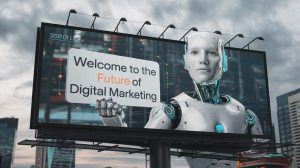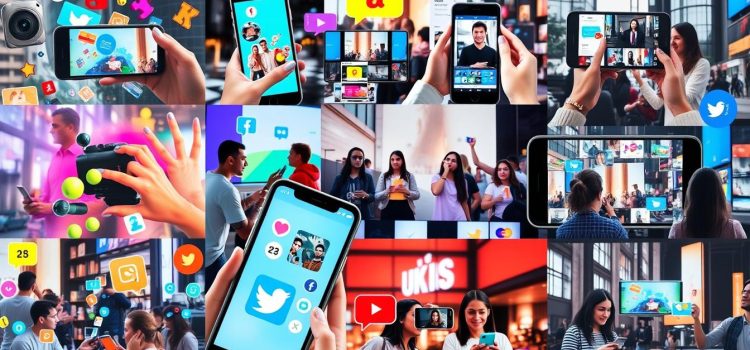
Introduction
Digital advertising is changing fast, and by 2025, it will look very different from today. New technologies, changing consumer habits, and new rules around privacy are all having an impact. As marketers, it’s important to keep up with these changes and find new ways to reach and connect with customers.
This article will explore the top 9 trends that are shaping digital advertising in 2025. By understanding these trends, businesses can stay ahead and improve their marketing strategies.
Top 9 Digital Advertising Trends in 2025
1. Artificial Intelligence and Automation

Artificial Intelligence (AI) is helping marketers work more efficiently. In 2025, AI will be used more for automating tasks like data analysis, creating personalized ads, and adjusting ad campaigns in real time. This means advertisers can save time and money while targeting the right people more effectively.
Impact on Advertisers:
- AI will help improve ad targeting
- Ads will be more personalized
- Campaigns will run more efficiently and with fewer mistakes
2. The Rise of Video Content

Video is one of the most popular ways people consume content today, and this trend will only grow in 2025. Short videos, live streaming, and interactive videos will be everywhere. Brands will use videos to tell stories, engage customers, and even sell products directly through the videos.
Impact on Advertisers:
- Videos will get more views than text or static ads
- Video ads will be creative and interactive
- More money will be spent on creating video content
3. Privacy and Data Protection Regulations

Privacy rules, like GDPR in Europe and CCPA in California, are already changing how advertisers collect and use data. In 2025, these rules will become stricter in many countries. Advertisers will have to be more transparent about how they use customer data and focus on collecting data directly from consumers (first-party data) rather than relying on third-party data.
Impact on Advertisers:
- More attention to data privacy and security
- Use of first-party data will grow
- Brands will work harder to earn customers’ trust
4. Voice Search and Smart Devices

Voice assistants like Siri, Alexa, and Google Assistant are becoming more popular, and by 2025, voice search will be a bigger part of how people search for products and services. Marketers will need to optimize their ads for voice search, which means using natural language and focusing on long-tail keywords that people speak instead of type.
Impact on Advertisers:
- Content will need to be optimized for voice search
- New opportunities to advertise through voice devices
- More natural and conversational ad formats
5. Augmented Reality (AR) and Virtual Reality (VR)

Augmented Reality (AR) and Virtual Reality (VR) are making waves in digital advertising. These technologies allow consumers to interact with products in fun and creative ways. For example, shoppers could try on clothes virtually or see how furniture fits in their home before buying. AR and VR are expected to become more common in 2025, giving advertisers new ways to connect with consumers.
Impact on Advertisers:
- More engaging and immersive experiences
- Consumers can try products virtually before buying
- AR and VR will help brands stand out
6. Influencer Marketing Continues to Grow

Influencer marketing has been a successful strategy for many brands, and it’s going to keep growing in 2025. However, the focus will shift toward working with micro and nano influencers—people with smaller but highly engaged audiences. Brands will also look for influencers whose values align with theirs, to make their partnerships feel more authentic.
Impact on Advertisers:
- More partnerships with smaller influencers
- Greater emphasis on authenticity in influencer marketing
- Brands will connect with niche communities
7. Interactive and Shoppable Ads

Shoppable ads, which let consumers buy products directly from an ad, will be everywhere in 2025. Interactive ads will allow consumers to engage with content in new ways, like taking polls, watching videos, or even customizing a product. These types of ads help brands make the buying process easier for customers.
Impact on Advertisers:
- Higher conversion rates as consumers can buy right from the ad
- More interaction with ads through fun, engaging features
- Direct shopping from video, social media, and websites
8. Programmatic Advertising and Real-Time Bidding

Programmatic advertising, which uses technology to buy and place ads automatically, is growing. Real-time bidding (RTB) lets advertisers bid for ad space instantly, which makes ads more efficient and targeted. This approach helps advertisers make quick decisions about where and when to place ads based on real-time data.
Impact on Advertisers:
- More control over ad spending
- Ads can be targeted and optimized in real time
- Campaigns become more efficient and cost-effective
9. Sustainability and Ethical Marketing

In 2025, consumers will care more about the environment and social issues. Brands that focus on sustainability and ethical business practices will stand out. Advertisers will need to show how their products are helping the planet or supporting important causes. By doing so, they can build stronger connections with their audience.
Impact on Advertisers:
- More focus on eco-friendly products and practices
- Advertisers will align their values with their target audience
- Brand loyalty will grow through ethical marketing
Growth of Digital Advertising Platforms

In the coming years, the number of digital platforms available for advertising will continue to grow. Social media sites like Instagram, TikTok, and Facebook will keep improving their ad tools, making it easier for businesses to connect with their audience. Along with these, new platforms could emerge, offering fresh opportunities for advertisers. As more people spend time online, businesses will have even more places to reach their target audience, whether through videos, posts, or sponsored content. The variety of platforms gives businesses the chance to choose the best one for their products and services.
The Importance of Personalization in Ads
One of the biggest trends in digital advertising is personalization. In 2025, ads will be more customized to each individual. By using data from a person’s browsing history, interests, and social media activity, advertisers can create ads that are more likely to catch their attention. Personalized ads make consumers feel like the brand understands them, which can lead to stronger connections and more sales. However, as personalized advertising grows, companies must ensure that they are using data responsibly to protect customer privacy.
The Impact of Video Ads

Video ads are one of the most powerful tools in digital advertising. In 2025, the popularity of video content will continue to rise, especially short-form videos. Platforms like TikTok and YouTube will remain key channels for advertisers to share their messages in a fun and engaging way. Video ads allow brands to tell stories, show off their products, and connect emotionally with their audience. As video becomes even more interactive, consumers will be able to engage with ads directly, creating a more immersive experience.
Targeting the Right Audience
Effective targeting is one of the main advantages of digital advertising. Unlike traditional methods, digital ads allow businesses to target specific groups of people based on their age, location, interests, and more. This means that businesses can make sure their ads reach people who are most likely to be interested in their products. In 2025, targeting will become even more precise, thanks to new tools and technologies. Advertisers will be able to reach potential customers at the right moment, increasing the chances of making a sale.
Challenges of Digital Advertising in 2025
Despite its many benefits, digital advertising in 2025 will also come with challenges. One of the biggest challenges is privacy. Consumers are becoming more concerned about how their data is used, and stricter privacy laws are being put in place. Advertisers will need to find new ways to collect data while respecting consumer privacy. Another challenge is keeping up with new technology. As AI, AR, and VR continue to evolve, businesses will need to invest in new tools and learn how to use them effectively. Additionally, standing out in a crowded digital space can be difficult, as consumers are exposed to a huge number of ads every day.
The Future of Digital Advertising in 2025 and Beyond

Looking ahead, digital advertising will continue to evolve. By 2025, new technologies will make ads even more personalized and interactive. Voice search and smart devices will become even more important, and virtual and augmented reality will offer new ways for businesses to engage with customers. As privacy regulations become stricter, advertisers will need to be transparent and trustworthy. The future of digital advertising will focus on creating experiences that are both relevant and respectful to consumers, building deeper connections with audiences in a rapidly changing world.
Analysis Table: Impact of Trends on Digital Advertising
| Trend | Effect on Digital Advertising | Advertiser Strategy |
|---|---|---|
| Artificial Intelligence & Automation | Helps automate tasks and improve targeting. | Use AI tools to create personalized, effective ads. |
| Video Content | Increases engagement and sales. | Focus on creating interactive and engaging video ads. |
| Privacy Regulations | Makes data collection more transparent and secure. | Build trust by using first-party data and following privacy rules. |
| Voice Search & Smart Devices | Creates new opportunities for voice-activated ads. | Optimize ads for voice search and conversational tones. |
| AR & VR | Provides interactive, immersive experiences for customers. | Use AR and VR to let customers try products virtually. |
| Influencer Marketing | Creates authentic connections with smaller, niche audiences. | Partner with micro-influencers whose values align with the brand. |
| Interactive & Shoppable Ads | Makes it easier for customers to buy directly from ads. | Create interactive ads that let consumers shop immediately. |
| Programmatic & RTB | Allows real-time targeting and optimization. | Use programmatic platforms to automatically buy ads and target specific audiences. |
| Sustainability & Ethical Marketing | Builds stronger relationships with environmentally conscious consumers. | Highlight sustainability and ethical practices in your marketing. |
Comparative Table: Traditional vs. Digital Advertising in 2025
| Feature | Traditional Advertising | Digital Advertising 2025 |
|---|---|---|
| Targeting | Broad targeting based on general demographics | Hyper-targeted ads based on real-time data |
| Consumer Engagement | Passive (TV, print, radio) | Active and interactive (social media, video, AR/VR) |
| Data Usage | Limited customer data | Advanced data analytics for personalized ads |
| Content Format | Static ads (TV, billboards) | Dynamic, engaging ads (video, interactive, shoppable) |
| Ad Placement | Fixed media (newspapers, TV) | Flexible (programmatic, RTB, social media) |
Conclusion
By 2025, digital advertising will be more dynamic, personal, and interactive than ever. AI, video content, privacy rules, and new technologies like AR and VR will make ads more engaging and effective. Advertisers will need to embrace these changes and stay focused on building trust with consumers, offering authentic experiences, and providing value.
Understanding these trends and adapting to them will help businesses connect with their audience in new and meaningful ways. Digital advertising will continue to evolve, and those who keep up will lead the way into the future.










